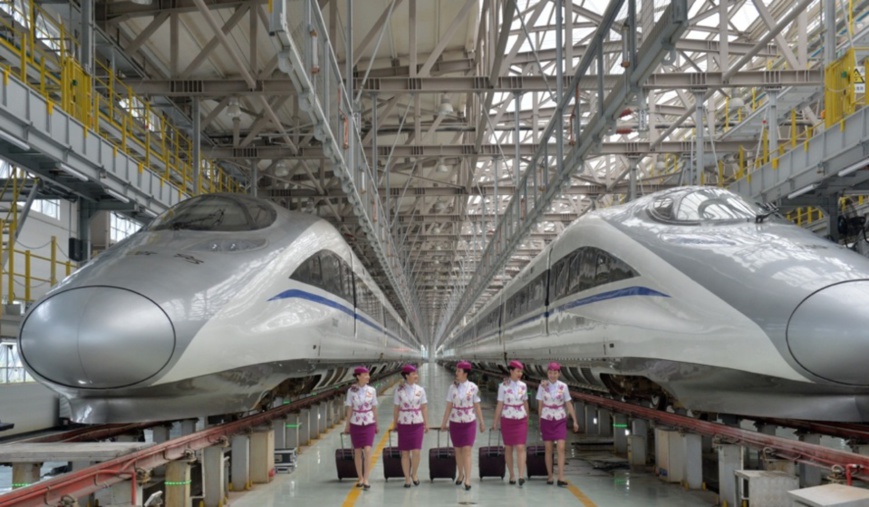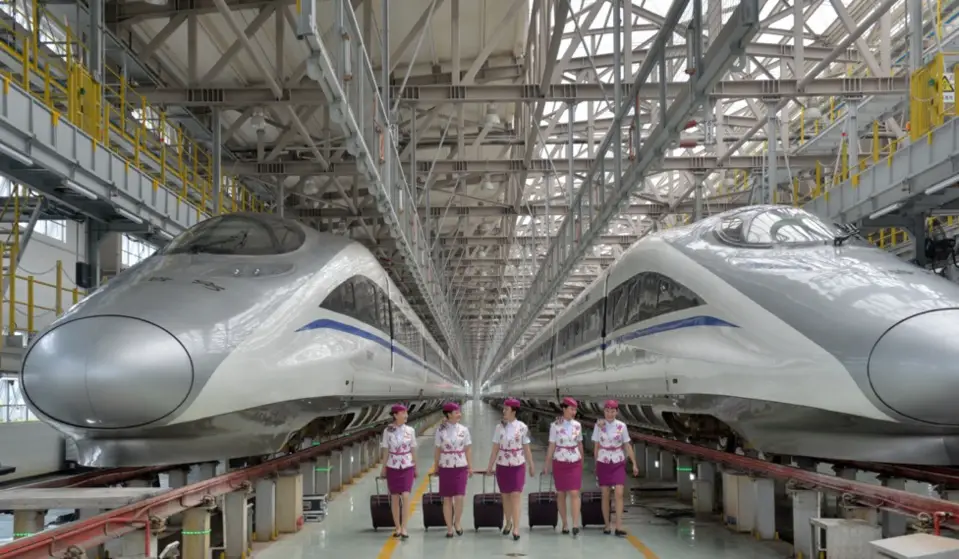By Lu Ya’nan, People’s Daily

The attendants of a bullet train debuting on the Anshun-Liupanshui high-speed rail, Guiyang, capital of Guizhou on July 3. Photo by Qiao Qiming/People’s Daily Online
By 2035, the total length of China’s railway tracks will reach about 200,000 km, including 7 km of high-speed railway, according to a recent outline on China’s railway development in the new era released by China State Railway Group Co., Ltd. (China Railway).
The document depicts a blueprint for the construction of railway network by the year of 2035, saying China will become a country with a strong and higher-level modern railway network by 2050.
As of the end of July, 2020, China’s operational railway length reached 141,400 km, ranking second in the world, while the high-speed rail network topped the world with a total length of 36,000 km.
“China’s high-speed railway network ranks first in the world in terms of operational mileage, scale of railways under construction, number of trains in service, and operational speed,” said Liang Dong, deputy director of the planning division of China Railway Economic and Planning Research Institute.
“Besides, China has the most complete technology system as well as the most operational scenarios and the most experience in the management of high-speed railways in the world,” Liang added.
In 2019, China’s railway network had covered 98 percent of the cities with a population of more than 200,000, up from 94 percent in 2012. The figure rose from 28 percent in 2012 to 86 percent last year for cities with a population of 500,000. All provincial capitals in the country except for Lhasa have connected to the high-speed railway network.
The average number of passengers taking China’s high-speed trains each day had risen from around 1.07 million person-times in 2012 to 6.38 million person-times in 2019, representing an average annual growth of 29.1 percent.
In addition, high-speed railway passengers had accounted for over half of the country’s total railway passengers for four consecutive years.
By 2035, all the Chinese cities with more than 200,000 people will be covered by railway network, and all cities with a population of more than 500,000 will be connected to high-speed rails, according to the outline. It suggests that the total length of operational high-speed railways in China will be nearly twice that of today by 2035.
China’s bullet train technologies has embraced rapid development since the country launched high-speed railway services over a decade ago.
The country now has more than 3,600 pairs of bullet trains, including 690 pairs of Fuxing bullet trains. Its number of high-speed trains is more than that in the rest of the world combined.
Today, China’s high-speed railway sector is marching towards higher goals for innovation.
“Faster speed, better performance in energy conservation and environmental protection, more comfortable train ride, smarter equipment and facilities, and lower life cycle costs are shared goals of railway operators and manufacturers of all countries. The new outline also suggests enhancing research, development, and application of new types of vehicles,” said Wu Guodong, deputy director of the locomotive and car department of China Railway.
According to the outline, China will master relevant core technologies and establish complete systems for key technologies including technical standards for high-speed railways that can reach speeds of 400 km per hour and faster through independent innovation.
China Railway is also making overall planning for research and development of new-generation CRH trains on the basis of the existing high-speed rails.
China will make efforts to independently research on and develop a new type of smart train control system, says the outline.
The new type of smart train control system will be an integrated control system that combines cutting-edge scientific and technological achievements such as the Beidou Navigation Satellite System (BDS) and 5G network, according to Mo Zhisong, head of the communication and signaling office of the department of track, communication and signaling and power supply of China Railway.
The new system can shorten the train tracking interval from the current minimum of three minutes to around two minutes and increase the transportation capacity of railways by over 30 percent, Mo disclosed.
“The new type of smart train control system will also gradually realize the transformation from the stage when trains need human drivers to the scenarios where they can run with an automated driving system and then a smart driving system,” Mo said.
Based on the current achievements in autonomous driving, China Railway is making efforts to push forward with progress in smart technologies including those that help improve train’s autonomous perception of environment and assessment of security situation, so as to reduce manual control and improve people’s travel experience, Mo added.
China’s high-speed trains will feature lower energy consumption and be more environmentally friendly in the future, according to Mo.
The bullet trains need the most power during acceleration. When they slow down, these trains do not consume electricity but generate power, Mo explained.
At present, research teams of China Railway are focusing efforts on coordinated and joint control of train groups, Mo said.
It can theoretically help reduce the per capita energy consumption per km by about 30 percent, according to Mo, who gave an example to illustrate the point, saying that new-generation high-speed trains can save about 9,000 kilowatt-hours of electricity during a round trip between Beijing and Shanghai.
The document depicts a blueprint for the construction of railway network by the year of 2035, saying China will become a country with a strong and higher-level modern railway network by 2050.
As of the end of July, 2020, China’s operational railway length reached 141,400 km, ranking second in the world, while the high-speed rail network topped the world with a total length of 36,000 km.
“China’s high-speed railway network ranks first in the world in terms of operational mileage, scale of railways under construction, number of trains in service, and operational speed,” said Liang Dong, deputy director of the planning division of China Railway Economic and Planning Research Institute.
“Besides, China has the most complete technology system as well as the most operational scenarios and the most experience in the management of high-speed railways in the world,” Liang added.
In 2019, China’s railway network had covered 98 percent of the cities with a population of more than 200,000, up from 94 percent in 2012. The figure rose from 28 percent in 2012 to 86 percent last year for cities with a population of 500,000. All provincial capitals in the country except for Lhasa have connected to the high-speed railway network.
The average number of passengers taking China’s high-speed trains each day had risen from around 1.07 million person-times in 2012 to 6.38 million person-times in 2019, representing an average annual growth of 29.1 percent.
In addition, high-speed railway passengers had accounted for over half of the country’s total railway passengers for four consecutive years.
By 2035, all the Chinese cities with more than 200,000 people will be covered by railway network, and all cities with a population of more than 500,000 will be connected to high-speed rails, according to the outline. It suggests that the total length of operational high-speed railways in China will be nearly twice that of today by 2035.
China’s bullet train technologies has embraced rapid development since the country launched high-speed railway services over a decade ago.
The country now has more than 3,600 pairs of bullet trains, including 690 pairs of Fuxing bullet trains. Its number of high-speed trains is more than that in the rest of the world combined.
Today, China’s high-speed railway sector is marching towards higher goals for innovation.
“Faster speed, better performance in energy conservation and environmental protection, more comfortable train ride, smarter equipment and facilities, and lower life cycle costs are shared goals of railway operators and manufacturers of all countries. The new outline also suggests enhancing research, development, and application of new types of vehicles,” said Wu Guodong, deputy director of the locomotive and car department of China Railway.
According to the outline, China will master relevant core technologies and establish complete systems for key technologies including technical standards for high-speed railways that can reach speeds of 400 km per hour and faster through independent innovation.
China Railway is also making overall planning for research and development of new-generation CRH trains on the basis of the existing high-speed rails.
China will make efforts to independently research on and develop a new type of smart train control system, says the outline.
The new type of smart train control system will be an integrated control system that combines cutting-edge scientific and technological achievements such as the Beidou Navigation Satellite System (BDS) and 5G network, according to Mo Zhisong, head of the communication and signaling office of the department of track, communication and signaling and power supply of China Railway.
The new system can shorten the train tracking interval from the current minimum of three minutes to around two minutes and increase the transportation capacity of railways by over 30 percent, Mo disclosed.
“The new type of smart train control system will also gradually realize the transformation from the stage when trains need human drivers to the scenarios where they can run with an automated driving system and then a smart driving system,” Mo said.
Based on the current achievements in autonomous driving, China Railway is making efforts to push forward with progress in smart technologies including those that help improve train’s autonomous perception of environment and assessment of security situation, so as to reduce manual control and improve people’s travel experience, Mo added.
China’s high-speed trains will feature lower energy consumption and be more environmentally friendly in the future, according to Mo.
The bullet trains need the most power during acceleration. When they slow down, these trains do not consume electricity but generate power, Mo explained.
At present, research teams of China Railway are focusing efforts on coordinated and joint control of train groups, Mo said.
It can theoretically help reduce the per capita energy consumption per km by about 30 percent, according to Mo, who gave an example to illustrate the point, saying that new-generation high-speed trains can save about 9,000 kilowatt-hours of electricity during a round trip between Beijing and Shanghai.
 Menu
Menu
 What will China’s railway network be like in 2035?
What will China’s railway network be like in 2035?
















